

Slips, Trips, And Falls Hazards | How To Prevent Them
Every year, countless individuals experience the unexpected mishap of a slip, trip, or fall. These incidents occur across all age groups and settings, from homes and public spaces to workplaces. While often brushed off as minor inconveniences or embarrassments, slips, trips, and falls can lead to serious injuries and significant financial and emotional costs.
The key to tackling this pervasive issue lies in understanding the factors contributing to these accidents and implementing effective prevention measures. In this blog, we delve into the causes of slips, trips, and falls, their impact, and, most importantly, how we can prevent them.
By understanding these risks, we empower ourselves to create safer environments, whether looking at the comfort of our homes, the safety of public spaces, or the well-being of employees in a workplace. This guide aims to heighten awareness, encourage preventive action, and highlight our shared responsibility in reducing the risks and consequences of slips, trips, and falls. Join us as we navigate through this important topic step by carefully step.
The Importance of Preventing Slips, Trips, and Falls
The impact of slips, trips, and falls can be highly significant, from bruised shins to broken bones. These incidents aren’t just about physical injury. The repercussions can ripple outwards, affecting an individual’s quality of life, workability, and mental well-being. In the workplace, such accidents can lead to significant downtime, loss of productivity, and even legal implications for businesses. It’s estimated that the annual costs associated with occupational falls run into billions of dollars globally, impacting not just individuals but entire economies. Therefore, it’s clear that these everyday accidents are anything but trivial and that preventing them should be a top priority for everyone.
Basic Understanding of Slips, Trips, and Falls
To prevent these incidents, we first need to understand them. So, what exactly are slips, trips, and falls? A slip occurs when there is too little friction or traction between your footwear and the walking surface, leading to a loss of balance. A trip happens when your foot or lower leg hits an object, and your upper body continues moving, resulting in loss of balance. A fall can result from a slip or trip but can also occur due to other factors, like poor lighting, lack of handrails, or sudden illness.
Each of these incidents can occur under various circumstances. While some common causes include wet or uneven surfaces, poor footwear, and cluttered walkways, there can also be less obvious contributors, like insufficient training or awareness. This article aims to delve deeper into the world of slips, trips, and falls, elucidating their causes, impacts, and, most importantly, the strategies for prevention. The goal is not to instill fear but to inspire a culture of safety, vigilance, and proactive measures to keep everyone safe.
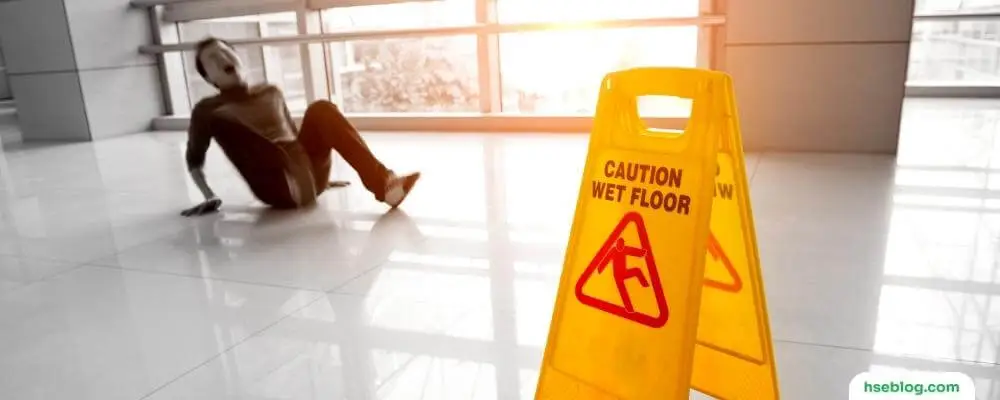
Definition and Differences: Slips, Trips, and Falls
While the terms ‘slips,’ ‘trips,’ and ‘falls’ are often used interchangeably, they refer to distinct occurrences. As we’ve already discussed, a slip occurs when there is insufficient traction between your foot and the walking surface. This lack of grip may cause an imbalance, leading you to fall.
Trips, on the other hand, occur when your foot contacts an object in its path or drops unexpectedly, causing you to lose balance. A trip might occur due to clutter, an obstacle in the pathway, or an uneven walking surface.
Finally, a fall is a sudden, uncontrolled descent for various reasons, including slips, trips, loss of consciousness, or other health-related issues. Falls can occur on the same level (for example, falling on the floor) or from one level to another (like falling down the stairs or from a ladder).
Common Causes of Slips, Trips, and Falls
Understanding the common causes of these incidents is the first step toward prevention. Below are some major factors that often contribute to slips, trips, and falls.
- Wet or Oily Surfaces: One of the most common causes of slips is the presence of wet or oily surfaces. This might occur in areas prone to spills or leaks, such as kitchens, bathrooms, and certain industrial environments.
- Uneven Surfaces, Irregularities, and Obstacles: Uneven walking surfaces or irregularities such as potholes, cracks, or abrupt transitions can cause trips. Obstacles might include clutter, cords, open drawers, and other items that haven’t been stored properly.
- Poor Lighting Conditions: Inadequate lighting can make it difficult to see and avoid potential hazards like spills, obstacles, or changes in level. This can lead to both trips and falls.
- Weather Hazards: Outdoor slips and falls often increase during bad weather conditions such as rain, snow, or ice, which make surfaces slippery and vision less clear.
- Human Factors: Rushing, distraction, fatigue, or lack of proper training can also contribute to slips, trips, and falls. These can often be mitigated through awareness and training.
- Improper Footwear: Footwear unsuitable for the work environment or the current weather conditions can increase the risk of slips, trips, and falls. For example, smooth-soled shoes might not provide enough traction on a wet or oily surface, leading to slips.
- Loose or Unsecured Mats or Rugs: Unsecured mats, rugs, or carpets can shift underfoot or present tripping hazards with their edges.
- Improper Use of Equipment: This might involve using chairs instead of ladders, climbing on shelves, or not using safety equipment correctly, all of which can lead to falls.
- Poor Housekeeping: If work and walkway areas are not kept clean and orderly, they can contribute significantly to slips, trips, and falls. Examples include cluttered workspaces, cables across walkways, or spills not promptly cleaned up.
- Lack of Safety Training: Employees not properly trained on the correct job procedures, including safety equipment, can be at higher risk for accidents.
- Inadequate Maintenance: Neglecting maintenance can lead to hazards such as leaky pipes (leading to wet surfaces), potholes, or uneven flooring, which can cause slips, trips, and falls.
- Poorly Designed Walkways: Walkways with sudden drops, absence of handrails, sharp turns, or inadequate space can increase the risk of falls.
- Medical Conditions: Certain conditions like poor vision, balance disorders, or mobility problems can also increase the risk of slips, trips, and falls.
- Age: Both the very young and the elderly are at an increased risk for falls, partly due to factors such as lack of coordination, decreased strength, or reduced balance.
Remember, while this list of causes is extensive, it is not exhaustive. There may be other contributing factors depending on the specific circumstances or environment. That’s why it’s crucial to carry out regular risk assessments to promptly identify and address potential hazards.
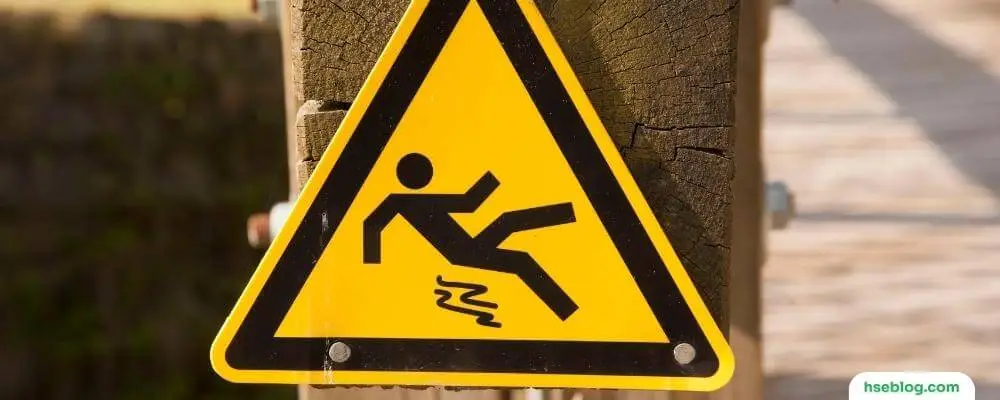
Impact and Consequences Of Slips, Trips, And Falls
The impacts of slips, trips, and falls extend beyond the immediate event and can have lasting effects on the individuals involved and the organizations they belong to. These incidents can result in physical injuries, financial costs, and psychological distress.
Physical Injuries: From Minor to Severe
Physical injuries resulting from slips, trips, and falls can range from minor to severe. Minor injuries may include bruises, abrasions, or sprains. At the same time, more severe cases can lead to fractures, concussions, or even life-threatening injuries such as traumatic brain injuries or spinal cord damage.
In some cases, these incidents can lead to chronic pain or long-term disability, affecting the individual’s ability to perform daily activities or return to work. Falls, in particular, can be especially dangerous for older adults, leading to hip fractures or other serious injuries that significantly impact their independence and quality of life.
Financial Implications: Costs of Accidents
The financial implications of these incidents are also considerable. For individuals, this can include medical expenses, rehabilitation costs, and lost wages during recovery. Additionally, they might face expenses related to modifying their home for accessibility if the fall leads to a long-term disability.
For businesses, the financial costs can be substantial. There are indirect costs besides direct costs like medical expenses and workers’ compensation claims. These can include lost productivity due to employee absence, costs related to training replacement employees, and potential increases in insurance premiums. In severe cases, businesses may also face legal fees if they are negligent in providing a safe environment.
Psychological Implications: Fear and Anxiety After a Fall
The psychological impacts of slips, trips, and falls should not be underestimated. People who have experienced such an incident may develop a fear of falling again. This fear can limit their activities, reduce their independence, and decrease their quality of life.
Anxiety, depression, and social isolation can also result from the fear of falling or the consequences of an injury, such as disability. Employees may experience stress or anxiety about returning to work, especially if they feel the environment is unsafe.
Understanding these impacts highlights the importance of preventive measures to ensure safe environments, reducing the risk of slips, trips, and falls. The following sections will explore strategies to identify potential hazards and implement effective control measures.
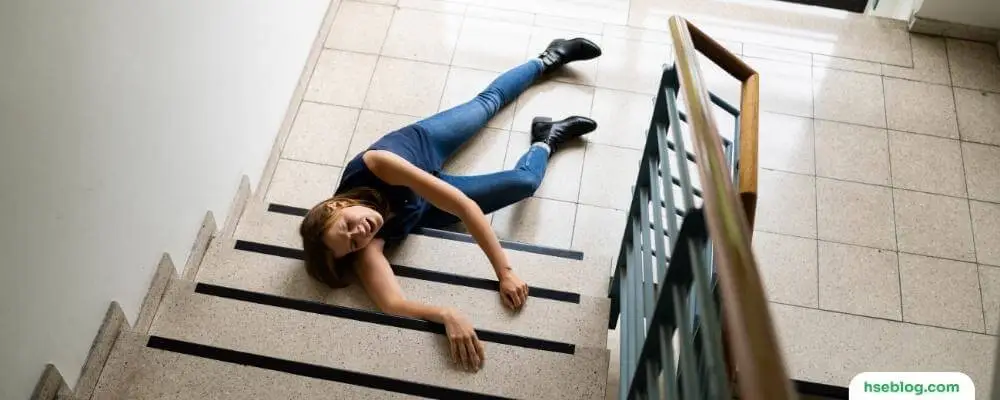
Slips, Trips, And Falls Hazards Risk Assessment
Risk assessment is critical in preventing slips, trips, and falls. It involves identifying potential hazards, evaluating their risks, and determining appropriate control measures. A thorough risk assessment should consider all areas and activities in a given environment, from the home to the workplace.
Identifying High-Risk Areas in the Home or Workplace
High-risk areas vary depending on the setting. These might include staircases, bathrooms, and kitchens in the home, where wet surfaces are common. Outdoor areas like driveways or walkways can also present risks, especially in adverse weather conditions. Any area without sufficient support structures could be risky for older adults or those with mobility issues.
In the workplace, high-risk areas could be those with heavy foot traffic, wet or uneven surfaces, or places with lots of equipment and machinery. Industrial kitchens, construction sites , warehouses, and healthcare facilities are examples of workplace environments that often have high-risk areas.
Key Considerations for Risk Assessment
A comprehensive risk assessment should consider various factors. These include:
- The Environment: Assess the condition of the floors, lighting, staircases, and walkways. Look for hazards like wet surfaces, uneven floors, poor lighting, or lack of handrails.
- Human Factors: Consider the behavior and health of individuals in the environment. Are they rushing? Are they carrying heavy items that may obstruct their view? Do they have any health conditions that increase their risk?
- Tasks: Evaluate the tasks being performed. Does the job involve working at height, handling hazardous substances, or heavy physical labor? Are workers exposed to distractions or time pressure?
- Footwear and Clothing: Assess whether appropriate footwear and clothing are worn for specific environments and tasks.
- Previous Incidents: Look at the history of slips, trips, and falls in the environment. A pattern might indicate a persistent problem that needs addressing.
Importance of Regular Safety Audits
Regular safety audits are essential to maintain a safe environment. These audits involve routinely inspecting the environment and practices to ensure that safety measures are up-to-date and effectively implemented. They help identify new or overlooked hazards and assess the effectiveness of current control measures.
Regular audits also demonstrate a commitment to safety, which can encourage individuals to take responsibility for their safety and that of others. This fosters a proactive safety culture where hazards are promptly reported and addressed, further reducing the risk of slips, trips, and falls.
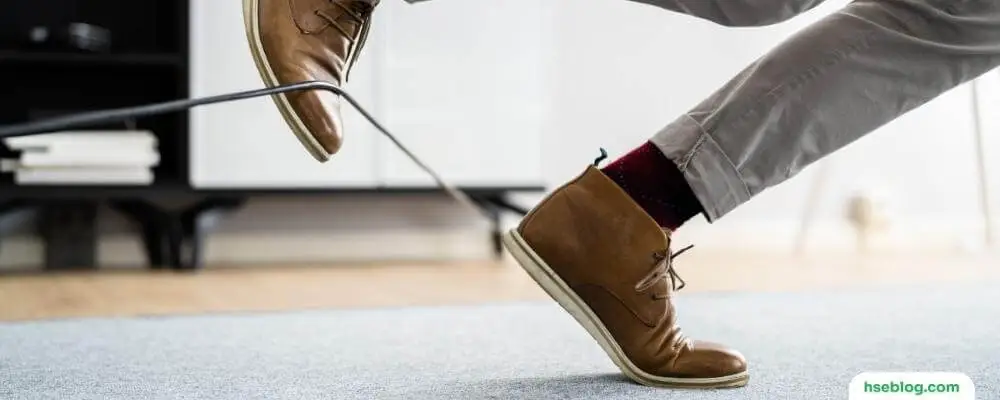
Prevention and Control Measures For Slips, Trips, And Falls
Once potential hazards have been identified through risk assessment, it’s crucial to implement prevention and control measures to mitigate these risks. This involves a range of strategies, from good housekeeping practices to installing safety features.
Housekeeping Best Practices
Proper housekeeping is one of the most effective ways to prevent slips, trips, and falls. Here are some best practices:
- Regular Cleaning: Clean floors regularly and immediately clean up any spills. Ensure to put up “wet floor” signs until the area is dry.
- Declutter: Keep walkways and work areas clear of clutter and obstacles.
- Proper Storage: Store materials and equipment properly when not in use.
- Maintenance: Promptly repair any damages to walkways and work areas, like cracks or uneven surfaces.
Installing Safety Features (Handrails, Non-Slip Mats, etc.)
Installing safety features can greatly reduce the risk of accidents. Here are a few examples:
- Handrails: Install sturdy handrails on all staircases and other areas where individuals may need extra support.
- Non-slip Mats: Use non-slip mats in areas prone to wet or slippery conditions.
- Guard Rails: Install guardrails around elevated platforms, mezzanines, and other fall hazards.
- Visible Markings: Use reflective tape or other visible markings to highlight changes in floor level or other hazards.
Appropriate Footwear for Different Surfaces
Wearing the right footwear can significantly reduce the risk of slips, trips, and falls. Choose shoes with good traction, especially for wet or slippery surfaces. Protective footwear should be worn in workplaces where specific hazards are present, such as construction sites.
Prompt Removal or Correction of Identified Hazards
Address identified hazards as quickly as possible to prevent accidents. If a hazard cannot be immediately removed or corrected, ensure it is clearly marked, and individuals are informed about it until it can be addressed.

Adequate Lighting
Ensure all areas have sufficient lighting to allow individuals to see and avoid potential hazards. This is particularly important for stairways, hallways, and outdoor paths. Replace burnt-out bulbs promptly and consider installing automatic lights in often-used areas.
By implementing these prevention and control measures, you can greatly reduce the risk of slips, trips, and falls, promoting a safer environment for everyone. In the next section, we’ll explore additional strategies and considerations specific to the workplace.
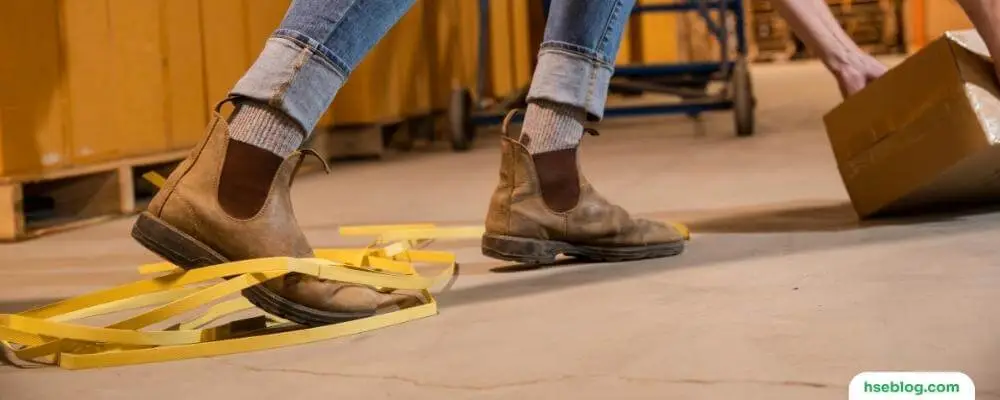
Workplace-Specific Considerations
While many of the principles of slips, trips, and falls prevention apply universally, certain considerations are particularly relevant to workplaces. These involve safety training, employer responsibilities, and industry-specific hazards.
Importance of Safety Training and Awareness Programs
Safety training is vital to workplace safety . Regular training sessions can ensure that employees are aware of potential hazards and the best practices for avoiding them. Training should cover topics such as proper use of equipment, safe handling of materials, and emergency procedures.
Awareness programs, too, can play a crucial role in maintaining a safe work environment. These programs could include regular safety reminders via bulletins, emails, or meetings, encouraging employees to be vigilant and proactive about safety.
Employer Responsibilities and Employee Rights
Employers have a responsibility to provide a safe work environment. This involves conducting regular risk assessments, addressing identified hazards promptly, and providing necessary safety training and equipment. They should also have procedures in place for reporting accidents or hazards and ensure that employees feel comfortable using these procedures without fear of retaliation.
Employees, on the other hand, have the right to a safe workplace and the right to speak up about safety concerns. They also have a role in maintaining safety by following established procedures, using provided safety equipment, and promptly reporting any hazards or incidents.
Industry-Specific Hazards and Control Measures
Every industry has its unique set of hazards, so it’s important to consider these when planning prevention and control measures. For example, spills and hot surfaces might be major hazards in a restaurant kitchen. Measures could include non-slip mats, appropriate footwear, and caution signs. In a construction site, falls from a height might be the primary concern, necessitating guardrails, safety harnesses, and fall arrest systems.
In conclusion, slips, trips, and falls are common but preventable incidents. By understanding their causes and impacts, conducting regular risk assessments, and implementing effective prevention and control measures, we can significantly reduce these accidents, fostering safer homes, workplaces, and communities.
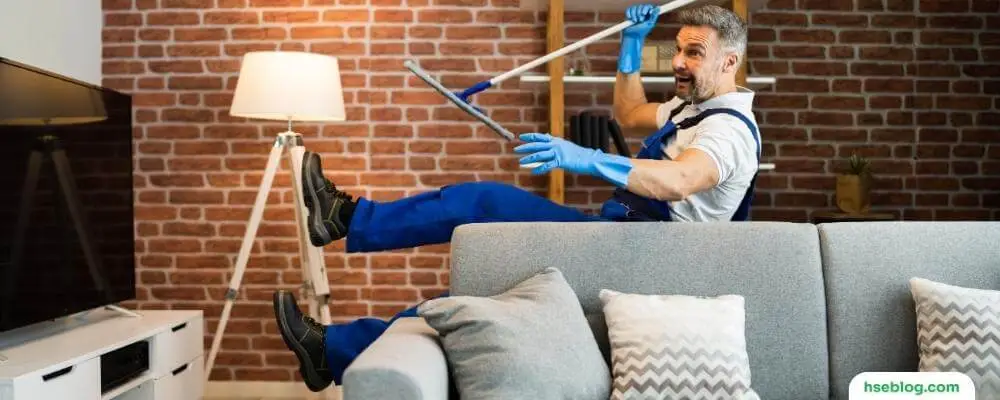
Preventing slips, trips, and falls is no small task, but it is a crucial one. As we’ve explored in this guide, these incidents are far from trivial, carrying the potential for serious physical injuries, significant financial costs, and profound psychological impacts. Yet, armed with the knowledge of what causes these incidents and understanding their impacts, we’re already halfway towards prevention.
The steps to creating safer environments—at home, in public spaces, or at workplaces—aren’t overly complex. They begin with recognizing the potential hazards and involve a thoughtful blend of risk assessment, implementing practical measures, and fostering a culture of safety awareness. From basic housekeeping to installing safety features, each action reduces the risk.
It’s important to remember that the responsibility of preventing slips, trips, and falls doesn’t rest on a single individual or group—it’s a collective effort. Employers, employees, homeowners, and public facility managers all have roles to play. And in our various roles, we all contribute to a larger, shared goal: creating safer environments for everyone.
Preparing for and preventing these incidents can seem daunting in a world where the unexpected is expected. But, as we’ve seen, it’s not only possible; it’s a critical part of our commitment to safety for ourselves and others. Let this guide serve as a reminder and resource for that commitment, helping us make each step we take a safer one. Thank you for joining us on this journey towards safer environments and greater awareness. Let’s continue to take steps, big and small, toward a safer tomorrow.
Waheed Riaz
Get More Inspiration & Our Latest News
Stay informed and protected with our exclusive updates delivered right to your inbox.
Welcome to the must-read blog for professionals in the health and safety field. Dive into the universe of health and safety with our enlightening blog crafted for professionals like you.
Quick Links
© Occupational Health and Safety Blog

- Weill Cornell Medicine

Slips, Trips, and Falls: Understanding, Preventing, and Mitigating Risks
By Gian Joseph, Safety Advisor
As we enter the rainy and cold season, we face several risks , which include slips , trips, and fall s in our day-to-day activities. It is important t o be aware of hazards around us and learn how to properly identify and assess any risks with each step.
Slips, trips, and falls (STFs) are common accidents that can lead to severe injuries. These incidents occur in various settings, from homes and workplaces to public spaces , and i t is essential to understand the causes, consequences, and , most importantly, strategies for prevention and mitigation.
1. Understanding the Dynamics of STFs. STFs are caused by the following .
Insu fficient friction between the shoe and the walking surface. Common causes include wet or greasy floors, spills, and loose debris (Slip and Fall Accidents, 2021).
When a person's foot collides with an object or an uneven surface, it caus es them to lose balance. Typical trip hazards include cluttered walkways, electrical cords, uneven flooring, and damaged or upturned mats (Slip and Fall Accidents, 2021).
2. The Impact of STFs
Slips, trips, and falls have far-reaching effects, affecting individuals and society . Personal i njuries range from minor cuts , bruises, sprains , and abrasions to fractures, dislocations, and head injuries (National Safety Council, 2021). The medical expenses associated with treating STF-related injuries can be substantial , including hospital stays, surgeries, rehabilitation, and ongoing care (National Safety Council, 2021). STFs can result in missed workdays and reduced productivity for both individuals and employers. Workers' compensation claims and absenteeism contribute to economic costs (National Safety Council, 2021). Lastly, t he physical and psychological consequences of STFs can limit mobility, independence, and overall quality of life, especially among older adults ( Sahyoun et al., 2020).
3. Prevention and Mitigation Strategies
Preventing and mitigating STFs involves a combination of awareness, environmental modifications, and education . H ere are some ways you can take precaution s against STFs in your daily activities;
Clear Pathways: Maintain clear, unobstructed walkways by removing clutter and tripping hazards such as cords, toys, and loose rugs (Occupational Safety and Health Administration [OSHA], 2002).
Adequate Lighting: Ensure proper lighting in all areas, both indoors and outdoors, to improve visibility and reduce the risk of tripping over obstacles (OSHA, 2002).
Slip-Resistant Flooring: Install slip-resistant flooring materials, especially in areas prone to moisture, like bathrooms and kitchens (OSHA, 2002).
Footwear: Encourage the use of proper footwear with good traction, especially in environments where slip hazards are prevalent ( Sahyoun et al., 2020).
Handrails and Guardrails: Install and maintain handrails and guardrails on stairs, ramps, and elevated platforms to provide support and prevent falls (OSHA, 2002).
Warning Signs: Use signage to alert individuals to potential hazards, such as wet floors or uneven surfaces (OSHA, 2002).
Education and Training: Promote awareness and provide training to individuals on recognizing and avoiding STF hazards (National Institute for Occupational Safety and Health [NIOSH], 2015).
Workplace Safety: Employers should implement safety protocols and conduct risk assessments in the workplace, addressing potential STF risks (NIOSH, 2015).
Regular Maintenance: Routinely inspect and maintain buildings, walkways, and outdoor areas to identify and address potential hazards promptly (NIOSH, 2015).
4. A Holistic Approach to STF Prevention
Preventing and mitigating STFs require a collaborative approach involving individuals, organizations, and communities:
Individuals : Exercise caution when walking, especially in unfamiliar or potentially hazardous environments. Wear appropriate footwear and take your time, especially in wet or slippery conditions ( Sahyoun et al., 2020).
Employers: Create a safe work environment by identifying and mitigating STF risks. Provide training to employees on safety protocols and the proper use of equipment (OSHA, 2002).
Property Owners and Managers: Ensure properties are well-maintained and free from hazards. Regularly inspect and address issues promptly (NIOSH, 2015).
Government and Local Authorities: Enforce building codes and regulations that promote safety, especially in public spaces and commercial buildings (OSHA, 2002).
Conclusion
Slips, trips, and falls are preventable accidents that carry substantial personal, economic, and societal costs. By comprehending the causes, consequences, and prevention strategies, we can significantly reduce the incidence of STFs and mitigate their impact. Whether at home, at work, or in public spaces, prioritizing safety and fostering awareness about STFs is crucial for the well-being of individuals and communities. Let us strive collectively to create environments where everyone can move safely and confidently, free from the fear of falling.
References:
National Institute for Occupational Safety and Health (NIOSH). (2015). Preventing Slips, Trips, and Falls in Wholesale and Retail Trade Establishments. https://www.cdc.gov/niosh/docs/2015-100/pdfs/2015-100.pdf
National Safety Council. (2021). Injury Facts. https://injuryfacts.nsc.org/work/overview/work-safety-introduction/work-...
Occupational Safety and Health Administration (OSHA). (2002). OSHA Publication 3151-12R. Preventing Slips, Trips, and Falls in Wholesale and Retail Trade Establishments. https://www.osha.gov/Publications/osha3151.pdf
Sahyoun , N. R., Pratt, L. A., & Lentzner , H. (2020). The Changing Profile of Nursing Home Residents: 1985-1997. Journal of Aging and Health, 12(3), 336-363.
Slip and Fall Accidents. (2021). InjuryClaimCoach.com. https://www.injuryclaimcoach.com/slip-and-fall-accidents.html
Please note that the sources cited are accurate as of the time of writing this article. For the most current information, consult authoritative sources and local health authorities.
Go to the staff directory for individual contacts within EHS. You may also use the Weill Cornell Medicine online directory to search for faculty and staff.
Create an EHS Incident
Weill Cornell Medicine Environmental Health and Safety 402 East 67th Street Room LA-0020 New York, NY 10065 Phone: (646) 962-7233 Fax: (646) 962-0288
- AI Generator
2,487 Slip Trip And Fall Hazard Stock Photos & High-Res Pictures
Browse 2,487 slip trip and fall hazard photos and images available, or start a new search to explore more photos and images..


Reducing slips, trips and falls
Hazard awareness and prevention strategies needed.

Fall hazards remain a common problem across multiple industries and workplaces. In 2019, worker deaths stemming from slips, trips and falls climbed 11.3% from the previous year, according to Bureau of Labor Statistics data. Meanwhile, OSHA’s standard on fall protection – general requirements (1926.501) has topped the agency’s Top 10 list of most frequently cited standards for 11 consecutive fiscal years.
Other standards related to inherent fall risks and that routinely populate the list include those regarding ladders (1926.1053), scaffolding (1926.451) and fall protection – training requirements (1926.503).
“Most workers have some safety knowledge, but how do we get people to consistently apply the safety practices that they know?” asked Bradley Evanoff, occupational health physician and professor of occupational and environmental medicine at Washington University in St. Louis. “How can an employer create a work culture where all employees take an active role in making the workplace safer and feel like they can speak up if they see a problem?”
Factors may overlap
During a December 2019 National Safety Council webinar on strategies for preventing slips, trips and falls, Amber Joseph, technical consultant at Liberty Mutual Insurance, identified several contributing factors. Among them:
- Walking surfaces
- People and activity
- Contaminants
“A lot of times, you’ll have overlap within these, so it may be a walking surface and a footwear discussion depending on the type of contaminant that you have in place,” Joseph said. “But really, it’s looking at this as a whole, and looking at it as, ‘All right, I need to address these areas as I move forward.’”
On the surface
Under OSHA’s standard on walking-working surfaces for general industry (1910.22), employers must ensure “all places of employment, passageways, storerooms, service rooms and walking-working surfaces are kept in a clean, orderly and sanitary condition.”
Walking-working surfaces also must be maintained free of hazards such as sharp or protruding objects, loose boards, corrosion, leaks, spills, snow, and ice. Additionally, hazardous conditions on surfaces must be “corrected or repaired before an employee uses the walking-working surface again.”
The standard adds that “if the correction or repair cannot be made immediately, the hazard must be guarded to prevent employees from using the walking-working surface until the hazard is corrected or repaired.”
NIOSH suggests that employers select flooring material based on the work that will be performed in the area. The agency also notes the importance of the factor of coefficient of friction – a measurement for the propensity to slip on a given walkway surface. The agency states that flooring with “a higher static coefficient of friction is safer” and recommends flooring with a CoF of 0.5 or greater for high-risk areas.
In November, the University of Pittsburgh announced that two researchers from its Swanson School of Engineering intend to use a NIOSH grant to develop a new model of flooring friction performance with the aim to prevent falls on the job. Citing data from Liberty Mutual, a Pitt press release notes that workplace slips and falls carry an annual expense of $10 billion in workers’ compensation claims.
Continued on page 2
Post a comment to this article
Safety+Health welcomes comments that promote respectful dialogue. Please stay on topic. Comments that contain personal attacks, profanity or abusive language – or those aggressively promoting products or services – will be removed. We reserve the right to determine which comments violate our comment policy. (Anonymous comments are welcome; merely skip the “name” field in the comment box. An email address is required but will not be included with your comment.)
Report Abusive Comment
- Skip to main content
- Skip to site information
- Departments
Language selection
- Français

Scheduled maintenance - Thursday, July 12 at 5:00 PM EDT
We expect this update to take about an hour. Access to this website will be unavailable during this time.
Prevention of Slips, Trips and Falls
On this page, how do falls happen, how to prevent falls due to slips and trips, what can you do to avoid falling at work.
Statistics show that the majority (67%) of falls happen on the same level resulting from slips and trips. The remaining 30% are falls from a height. This document will summarize information on "falls on the same level" (slips and trips). Falls from an elevation, such as falls from ladders, roofs, down stairs or from jumping to a lower level, etc., is discussed in other documents since each type of fall must be assessed as part of a fall prevention program .
Slips happen where there is too little friction or traction between the footwear and the walking surface. Common causes of slips are:
- wet or oily surfaces
- occasional spills
- weather hazards
- loose, unanchored rugs or mats
- flooring or other walking surfaces that do not have the same degree of traction in all areas
Trips happen when your foot collides (strikes, hits) an object causing you to lose balance and, eventually fall. Common causes of tripping are:
- obstructed view
- poor lighting
- clutter in your way
- wrinkled carpeting
- uncovered cables
- bottom drawers not being closed
- uneven (steps, thresholds) walking surfaces
Both slips and trips result from unintended or unexpected change in the contact between the feet and the ground or walking surface. This fact shows that good housekeeping, quality of walking surfaces (flooring), selection of proper footwear, and appropriate pace of walking are critical for preventing fall incidents.
Housekeeping
Good housekeeping is the first and the most important (fundamental) level of preventing falls due to slips and trips. It includes:
- cleaning all spills immediately
- marking spills and wet areas
- mopping or sweeping debris from floors
- removing obstacles from walkways and always keeping walkways free of clutter
- securing (tacking, taping, etc.) mats, rugs and carpets that do not lay flat
- always closing file cabinet or storage drawers
- covering cables that cross walkways
- keeping working areas and walkways well lit
- replacing used light bulbs and faulty switches
Without good housekeeping practices, any other preventive measures such as installation of sophisticated flooring, specialty footwear or training on techniques of walking and safe falling will never be fully effective.
For more information about effective housekeeping, visit the OSH Answers document on Workplace Housekeeping - Basic Guide .
Changing or modifying walking surfaces is the next level of preventing slip and trips. Recoating or replacing floors, installing mats, pressure-sensitive abrasive strips or abrasive-filled paint-on coating and metal or synthetic decking can further improve safety and reduce the risk of falling. However, it is critical to remember that high-tech flooring requires good housekeeping as much as any other flooring. In addition, resilient, non-slippery flooring prevents or reduces foot fatigue and contributes to slip-prevention measures.
In workplaces where floors may be oily or wet or where workers spend considerable time outdoors, prevention of fall incidents should focus on selecting proper footwear. Since there is no footwear with anti-slip properties for every condition, consultation with manufacturers is highly recommended.
Properly fitting footwear increases comfort and prevents fatigue which, in turn, improves safety for the employee. For more information on footwear visit the OSH Answers document on Safety Footwear .
You can reduce the risk of slipping on wet flooring by:
- taking your time and paying attention to where you are going
- adjusting your stride to a pace that is suitable for the walking surface and the tasks you are doing
- walking with the feet pointed slightly outward
- making wide turns at corners
You can reduce the risk of tripping by:
- keeping walking areas clear from clutter or obstructions
- keeping flooring in good condition
- always using installed light sources that provide sufficient light for your tasks
- using a flashlight if you enter a dark room where there is no light
- making sure that things you are carrying or pushing do not prevent you from seeing any obstructions, spills, etc.
- Fact sheet last revised: 2023-03-28

New Pig Technical Team
Our Tech Team is a group of experts that is dedicated to answering all your regulation questions! We can be reached at 1-800-HOT-HOGS (468-4647) or by email at [email protected].
Leave a Reply
Cancel reply.
Your email address will not be published. Required fields are marked *
Save my name, email, and website in this browser for the next time I comment.
- Previous Post Customer Questions: Do You Offer Spill Kit Inspection Checklists
- Next Post Customer Questions: Can I Close a Fire Exit During Construction
NEW PIG • PO BOX 304, TIPTON, PA 16684-0304 1-855-493-HOGS (493-4647) • Fax: 1-800-621-PIGS (621-7447) • [email protected]

© 2024 New Pig Corporation. All rights reserved. Trademarks • Privacy Policy • Terms of Use
- Name First Last
- AI Generator

IMAGES
VIDEO
COMMENTS
Given this, it's best to place proper lighting in access and egress points such as halls, ramps, stairs, and exits. 3. Install safety signs. Safety signs and markers are a must in preventing slips, trips, and falls. Installing them warns people about walking in hazardous spaces to keep them safe.
Dock worker injured lay down on the floor. of 42. Browse Getty Images' premium collection of high-quality, authentic Slip Trip And Fall Hazard stock photos, royalty-free images, and pictures. Slip Trip And Fall Hazard stock photos are available in a variety of sizes and formats to fit your needs.
Browse 178,600+ slip trip fall stock photos and images available, or search for safety or tripping hazard to find more great stock photos and pictures. safety tripping hazard
An industrial, warehouse, workplace safety topic. An employee risks injury by slipping on a plastic water bottle. Slips, trips and falls are major contributors to safety incidents in distribution centers, and factories. slip trip and fall hazard stock pictures, royalty-free photos & images
That means preventing slips, trips, and falls is an ongoing process that relies heavily on employees being able to recognize related hazards. What Are OSHA's Trip Hazard Regulations? OSHA's primary standard for slip, trip, and fall hazards is the General Industry Walking-Working Surface standard (29 CFR 1910 Subpart D, which includes §1910.21-30).
Appropriate Footwear for Different Surfaces. Wearing the right footwear can significantly reduce the risk of slips, trips, and falls. Choose shoes with good traction, especially for wet or slippery surfaces. Protective footwear should be worn in workplaces where specific hazards are present, such as construction sites.
Slips, trips, and falls have far-reaching effects, affecting individuals and society. Personal i njuries range from minor cuts, bruises, sprains, and abrasions to fractures, dislocations, and head injuries (National Safety Council, 2021). The medical expenses associated with treating STF-related injuries can be substantial, including hospital stays, surgeries, rehabilitation, and ongoing care ...
Slip, Trip, and Fall Prevention | 5 Table 1. Slip, trip and fall (STF) workers' compen-sation claims by body part injured, 1996-2005. Body part n % of total STF claims Lower extremities 185 44.9 Upper extremities 69 16.7 Multiple body parts 67 16.7 Back/trunk 73 16.2 Head/neck 18 4.3 Unknown 60 12.7 Total 472 100.0 Source: Bell et al. 2008 ...
A fall can end in death or disability in a split second, but with a few simple precautions, you'll be sure stay safe at home and at work. The second leading cause of unintentional injury-related death is falls, resulting in 42,114 deaths at home and at work. Depending on the industry, falls can be the leading cause of death at work.
Browse Getty Images' premium collection of high-quality, authentic Slip Trip And Fall Hazard stock photos, royalty-free images, and pictures. Slip Trip And Fall Hazard stock photos are available in a variety of sizes and formats to fit your needs.
Browse 85,600+ slip hazard stock photos and images available, or search for slip hazard sign to find more great stock photos and pictures. slip hazard sign. Sort by: Most popular. Wet floor sign. caution slippery surface sign. caution wet floor sign at a stairway. A worker tripping over an electrical cord in an industrial...
recognize fall hazards to prevent injuries from occurring. View the world from a safety lens The truth is that hazards are all around us. Sometimes it is difficult to see them, especially when we are working in familiar conditions. Instead of going through our usual routines, we should always stay vigilant and keep an eye out for safety. It
Fall hazards remain a common problem across multiple industries and workplaces. In 2019, worker deaths stemming from slips, trips and falls climbed 11.3% from the previous year, according to Bureau of Labor Statistics data. Meanwhile, OSHA's standard on fall protection - general requirements (1926.501) has topped the agency's Top 10 list ...
Housekeeping. Good housekeeping is the first and the most important (fundamental) level of preventing falls due to slips and trips. It includes: cleaning all spills immediately. marking spills and wet areas. mopping or sweeping debris from floors. removing obstacles from walkways and always keeping walkways free of clutter.
Follow these tips to prevent slips, trips and falls. • Clean up spills immediately. • Install warning signs for wet floor areas (including freshly mopped floors). • Wear shoes with good support and slip-resistant soles appropriate for the job task. • Remove tripping hazards in walkways, doorways and stairs.
Workplace injuries from slips, trips and falls result in more than 260,000 missed workdays a year. The average worker misses 11 days of work following such injuries. And these injuries cost employers an average of $20,000 per incident, according to EHS Today, a trade magazine for environmental health and safety professionals.
A male ice climber stands in the intrench way to a large ice cav. of 100. Browse Getty Images' premium collection of high-quality, authentic Tripping Hazard stock photos, royalty-free images, and pictures. Tripping Hazard stock photos are available in a variety of sizes and formats to fit your needs.
Slips, trips and falls are common workplace hazards. So common, in fact, that they are the second-leading cause of lost-worktime injuries. However, many facilities overlook the need to evaluate slip, trip and fall hazards—perhaps because these types of incidents are not directly tied to specific job duties or tasks, unlike those identified during a job hazard analysis (JHA).
A worker slips on leaking hydraulic oil from a forklift. of 1. Browse Getty Images' premium collection of high-quality, authentic Slips Trips And Falls stock photos, royalty-free images, and pictures. Slips Trips And Falls stock photos are available in a variety of sizes and formats to fit your needs.
Slip, Trip, and Fall Prevention for Healthcare Workers. According to the U.S. Bureau of Labor Statistics [2009], the incidence rate of lost-workday injuries from slips, trips, and falls (STFs) on the same level in hospitals was 38.2 per 10,000 employees, which was 90% greater than the average rate for all other private industries combined (20.1 ...
An industrial, warehouse, workplace safety topic. An employee risks injury by slipping on a plastic water bottle. Slips, trips and falls are major contributors to safety incidents in distribution centers, and factories. tripping hazard stock pictures, royalty-free photos & images
high rates of slip, trip, and fall (STF) injuries. The National Institute for Occupational Safety and Health (NIOSH) recommends measures to ensure a safe workplace and prevent injuries. Figure 1. Spilled liquid on a floor that may cause slips. Preventing Slips, Trips, and Falls in Wholesale and Retail Trade Establishments Description of the Problem